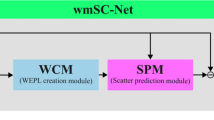Abstract
Objective
To clarify the relationship between entrance surface dose (ESD) and physical image quality of original and bone-suppressed chest radiographs acquired using high and low tube voltages.
Methods
An anthropomorphic chest phantom and a 12-mm diameter spherical simulated nodule with a CT value of approximately + 100 HU were used. The lung field in the chest radiograph was divided into seven areas, and the nodule was set in a total of 66 positions. A total of 264 chest radiographs were acquired using four ESD conditions: approximately 0.3 mGy at 140 and 70 kVp and approximately 0.2 and 0.1 mGy at 70 kVp. The radiographs were processed to produce bone-suppressed images. Differences in contrast and contrast-to-noise ratio (CNR) values of the nodule between each condition and between the original and bone-suppressed images were analyzed by a two-sided Wilcoxon signed-rank test.
Results
In the areas not overlapping with the ribs, both contrast and CNR values were significantly increased with the bone-suppression technique (p < 0.01). In the bone-suppressed images, these values of the three conditions at 70 kVp were equal to or significantly higher than those of the condition at 140 kVp. There was no apparent decrease in these values between the ESD of approximately 0.3 and 0.1 mGy at 70 kVp.
Conclusion
By using the shortest exposure time and the lowest tube voltage possible not to increase in blurring artifact and image noise, it is possible to improve the image quality of bone-suppressed images and reduce the patient dose.
Key Points
• The effectiveness of bone-suppression techniques differs in areas of lung field.
• Image quality of bone-suppressed chest radiographs is improved by lower tube voltage.
• Applying lower tube voltage to bone-suppressed chest radiographs leads to dose reduction.






Similar content being viewed by others
Abbreviations
- CNR:
-
Contrast-to-noise ratio
- ESD:
-
Entrance surface dose
- mAs:
-
Milliampere-second
- ROI:
-
Region of interest
References
Huda W, Abrahams RB (2015) Radiographic techniques, contrast, and noise in X-ray imaging. AJR Am J Roentgenol 204:W126–W131
Kuwahara C, Aoki T, Oda N et al (2019) Optimal beam quality for chest flat panel detector system: realistic phantom study. Eur Radiol. https://doi.org/10.1007/s00330-019-5998-1
Ullman G, Sandborg M, Dance DR, Hunt RA, Alm Carlsson G (2006) Towards optimization in digital chest radiography using Monte Carlo modelling. Phys Med Biol 51:2729–2743
Uffmann M, Neitzel U, Prokop M et al (2005) Flat-panel-detector chest radiography: effect of tube voltage on image quality. Radiology 235:642–650
Metz S, Damoser P, Hollweck R et al (2005) Chest radiography with a digital flat-panel detector: experimental receiver operating characteristic analysis. Radiology 234:776–784
Szucs-Farkas Z, Patak MA, Yuksel-Hatz S, Ruder T, Vock P (2008) Single-exposure dual-energy subtraction chest radiography: detection of pulmonary nodules and masses in clinical practice. Eur Radiol 18:24–31
Li F, Engelmann R, Doi K, MacMahon H (2008) Improved detection of small lung cancers with dual-energy subtraction chest radiography. AJR Am J Roentgenol 190:886–891
Schalekamp S, van Ginneken B, Meiss L et al (2013) Bone-suppressed images improve radiologists’ detection performance for pulmonary nodules in chest radiographs. Eur J Radiol 82:2399–2405
Freedman MT, Lo SC, Seibel JC, Bromley CM (2011) Pulmonary nodules: improved detection with software that suppresses the rib and clavicle on chest radiographs. Radiology 260:265–273
Li F, Hara T, Shiraishi J, Engelmann R, MacMahon H, Doi K (2011) Improved detection of subtle pulmonary nodules by use of chest radiographs with bone-suppression imaging: receiver operating characteristic analysis with and without localization. AJR Am J Roentgenol 196:W535–W541
Li F, Engelmann R, Pesce L, Armato SG 3rd, Macmahon H (2012) Improved detection of focal pneumonia by chest radiography with bone-suppression imaging. Eur Radiol 22:2729–2735
Takagi S, Yaegashi T, Ishikawa M (2019) Relationship between tube voltage and physical image quality of pulmonary nodules on chest radiographs obtained using the bone-suppression technique. Acad Radiol 26:e174–e179
EC (1996) European guidelines of quality criteria for diagnostic radiographic images. EUR 16260 EN. European Commission
Bernhardt TM, Rapp-Bernhardt U, Lenzen H et al (2004) Low-voltage digital selenium radiography: detection of simulated interstitial lung disease, nodules, and catheters―a phantom study. Radiology 232:693–700
Bernhardt TM, Rapp-Bernhardt U, Lenzen H et al (2004) Diagnostic performance of a flat-panel detector at low tube voltage in chest radiography: a phantom study. Invest Radiol 39:97–103
ICRP (1991) 1990 recommendations of the International Commission on Radiological Protection. ICRP publication 60. Ann ICRP 21(1–3) Oxford, Pergamon Press
Hamer OW, Sirlin CB, Strotzer M et al (2005) Chest radiography with a flat-panel detector: image quality with dose reduction after copper filtration. Radiology 237:691–700
Dobbins JT 3rd, Samei E, Chotas HG et al (2003) Chest radiography: optimization of X-ray spectrum for cesium iodide-amorphous silicon flat-panel detector. Radiology 226:221–230
Acknowledgments
The authors thank to Naoki Miyamoto for providing an anthropomorphic phantom.
Funding
The authors state that this work has not received any funding.
Author information
Authors and Affiliations
Corresponding author
Ethics declarations
Guarantor
The scientific guarantor of this publication is Satoshi Takagi.
Conflict of interest
The authors declare that they have no conflict of interest.
Statistics and biometry
No complex statistical methods were necessary for this paper.
Informed consent
Written informed consent was not required because this was a phantom study.
Ethical approval
This phantom study did not require institutional review board approval.
Methodology
• Experimental
• Performed at one institution
Additional information
Publisher’s note
Springer Nature remains neutral with regard to jurisdictional claims in published maps and institutional affiliations.
Rights and permissions
About this article
Cite this article
Takagi, S., Yaegashi, T. & Ishikawa, M. Dose reduction and image quality improvement of chest radiography by using bone-suppression technique and low tube voltage: a phantom study. Eur Radiol 30, 571–580 (2020). https://doi.org/10.1007/s00330-019-06375-6
Received:
Revised:
Accepted:
Published:
Issue Date:
DOI: https://doi.org/10.1007/s00330-019-06375-6




